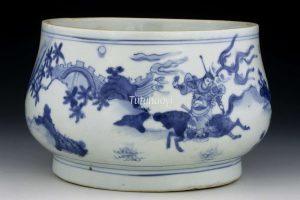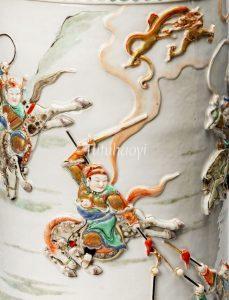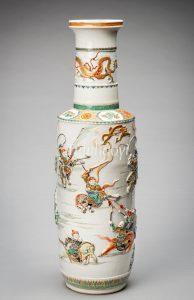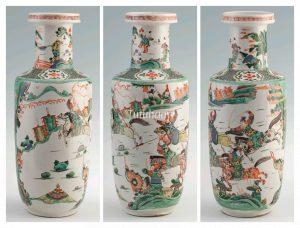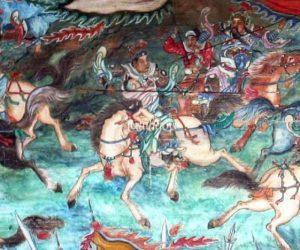Zhao Zilong’s solo rescue of Liu Bei’s infant son
赵子龙单骑救主
© Tutuhaoyi.com owns the copyright of the description content for the images attached. Quoting all or part of the description content on this page is permitted ONLY IF ‘Tutuhaoyi.com’ is clearly acknowledged anywhere your quote is produced unless stated otherwise. (本页描述内容版权归Tutuhaoyi.com所有,转发或引用需注明 “Tutuhaoyi.com”, 侵权必究, 已注开源信息的条目除外。)
According to the ‘Account of Zhao Yun’ (赵云传) in ‘The Records of the Three Kingdoms’ (三国志), Zhao Yun (styled Zilong, 子龙) was a distinguished general serving under his warlord, Liu Bei 刘备. It is said that Zhao was not only handsome and sturdy-built, but also brave and skilled in battle. In Chapters 41 to 42 of ‘Romance of the Three Kingdoms’ (三国演义 Sanguo Yanyi), it is recorded that in 208 CE during the Eastern Han dynasty, Liu Bei lost a battle to his opponent Cao Cao 曹操 at Changbanpo 长坂坡. Liu Bei fled south with his troops, leaving behind his wife Lady Mi and infant son Liu Shan (刘禅, nickname A’Dou 阿斗). The brave Zhao Yun went back to the battlefield seven times to search for Liu’s lost family and eventually found Lady Mi holding A’Dou and crying beside a well. Lady Mi thanked Zhao for saving her son’s life but then turned and jumped into the well so as not to burden Zhao on his way out. Zhao tied the infant A’Dou onto his trunk and fought fiercely against Cao’s army. It is said that he fought off more than fifty warriors before finally reuniting with his warlord Liu Bei.
story scene description by Rachel Ma
Related Figures and Stories:
Liu Bei and Sun Quan chopping stone 刘备孙权砍石问天(孙刘试剑)
General Zhou Yu Flogging Huang Gai 周瑜打黄盖 (苦肉计)
Fig 1-2: porcelain ‘gui’ censer with underglaze blue decoration, 1625, Tianqi period (1621–27), Ming dynasty, courtesy of the Trustees of the British Museum
Fig 3: porcelain vase with underglaze blue decoration, 17th century, courtesy of Hargesheimer Auction House, 07-10 September 2022, Lot 978
Fig 4-5: porcelain vase with overglaze enamelled decoration, Kangxi period (1662–1722), Qing dynasty, courtesy of Taft Museum of Art, Cincinnati, Accession Number: 1931.140
Fig 6-7: porcelain vase with overglaze enamelled decoration, Kangxi period (1662–1722), Qing dynasty, courtesy of Shanghai Museum, China
Fig 8-9: fresco, Republic period (1911–49), the Long Corridor of the Summer Palace, Beijing, China. Photograph taken on April 17, 2005 by Rolf Müller (User:Rolfmueller) – Own work, CC BY-SA 3.0
